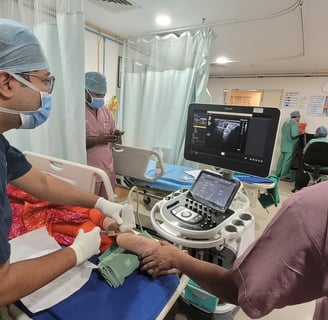What is the role of Ultrasound in Pain management intervention?
Blog post description.
8/7/20243 min read


The Role of Ultrasound in Pain Management Intervention
Ultrasound technology, long valued for its diagnostic capabilities, has increasingly become a pivotal tool in pain management interventions. This non-invasive imaging technique provides real-time visualization of tissues, allowing for precise and effective interventions in pain management. This article explores the role of ultrasound in pain management, detailing its benefits, applications, and impact on patient care.
What is Ultrasound in Pain Management?
Ultrasound uses high-frequency sound waves to produce images of the inside of the body. In pain management, ultrasound is utilized to guide various interventional procedures, such as injections and nerve blocks. Its real-time imaging capabilities allow healthcare providers to accurately target specific areas, minimizing risks and improving outcomes.
Benefits of Ultrasound in Pain Management
Enhanced Precision: Ultrasound provides real-time imaging, allowing for precise localization of anatomical structures and the exact placement of needles. This precision is crucial for targeting nerves, muscles, or joints, reducing the likelihood of complications and improving the efficacy of the intervention.
Reduced Risk of Complications: By visualizing the needle in real-time, ultrasound guidance helps avoid critical structures such as blood vessels and nerves, thereby minimizing the risk of accidental damage or adverse effects.
Minimally Invasive: Ultrasound-guided interventions are generally less invasive compared to traditional surgical approaches. This means reduced recovery time, lower risk of infection, and less discomfort for the patient.
Improved Patient Safety: The ability to visualize the injection site in real-time ensures accurate delivery of medication or other interventions, which enhances patient safety and the likelihood of achieving desired outcomes.
Dynamic Assessment: Ultrasound allows for dynamic assessment of the targeted area. This can be particularly useful for evaluating the effectiveness of the intervention in real-time and making necessary adjustments during the procedure.
Applications of Ultrasound in Pain Management
Nerve Blocks: Ultrasound guidance is commonly used for performing nerve blocks. By visualizing the nerve and surrounding structures, providers can accurately inject anesthetics or other medications to relieve pain from conditions such as sciatica or peripheral neuropathy.
Joint Injections: For conditions like arthritis or bursitis, ultrasound can guide injections directly into the affected joint or bursa. This ensures that the medication is delivered precisely where it is needed for maximum therapeutic effect.
Muscle and Tendon Injections: Ultrasound can also assist in injecting medication into specific muscles or tendons, such as in cases of tendinitis or muscle strains. This targeted approach helps alleviate pain and promote healing.
Biopsy Guidance: In cases where a biopsy is necessary to diagnose the cause of pain, ultrasound can guide the needle to the precise location for sampling, ensuring accurate results and reducing patient discomfort.
Impact on Patient Care
Enhanced Accuracy and Effectiveness: The use of ultrasound in pain management interventions increases the accuracy of procedures, which can lead to better pain relief and faster recovery for patients. Accurate targeting of therapeutic agents often results in more effective pain control and reduced need for repeat procedures.
Increased Patient Comfort: The minimally invasive nature of ultrasound-guided procedures often means less pain and quicker recovery for patients. This improved comfort can lead to higher patient satisfaction and better overall treatment experiences.
Streamlined Procedure: Ultrasound guidance can reduce the time required for interventions, as providers can quickly and accurately locate the target area. This efficiency benefits both the patient and the healthcare system by minimizing procedure time and associated costs.
Customized Treatment Plans: The real-time feedback provided by ultrasound allows healthcare providers to tailor treatment plans based on the patient's specific anatomy and response to the intervention. This personalized approach can lead to more effective and targeted pain management.
Challenges and Considerations
Technical Expertise: Effective use of ultrasound in pain management requires skilled operators who are proficient in both ultrasound imaging and the associated interventions. Training and experience are crucial for maximizing the benefits of this technology.
Equipment Limitations: While ultrasound is highly effective for many applications, there are limitations based on the quality of the equipment and the specific clinical scenario. Not all conditions or anatomical structures are equally visible on ultrasound.
Cost and Accessibility: The availability of high-quality ultrasound equipment and trained personnel can be a limiting factor in some healthcare settings, potentially affecting access to ultrasound-guided interventions.
Conclusion
Ultrasound has emerged as a powerful tool in pain management, offering real-time imaging that enhances precision, reduces risks, and improves patient outcomes. Its applications in nerve blocks, joint injections, muscle and tendon treatments, and biopsy guidance demonstrate its versatility and value in modern pain management practices. As technology continues to advance and training expands, the role of ultrasound in pain management is likely to grow, further enhancing the ability to deliver effective and patient-centered care.
Dr Chatterjee's Pain & Spine Clinic
CONTACT US
Services
The Mission Hospital, Durgapur
Phone: 086875 00500
Address: Immon Kalyan Sarani, Sector IIC, Bidhannagar, Durgapur, West Bengal 713212
© 2024. All rights reserved.


